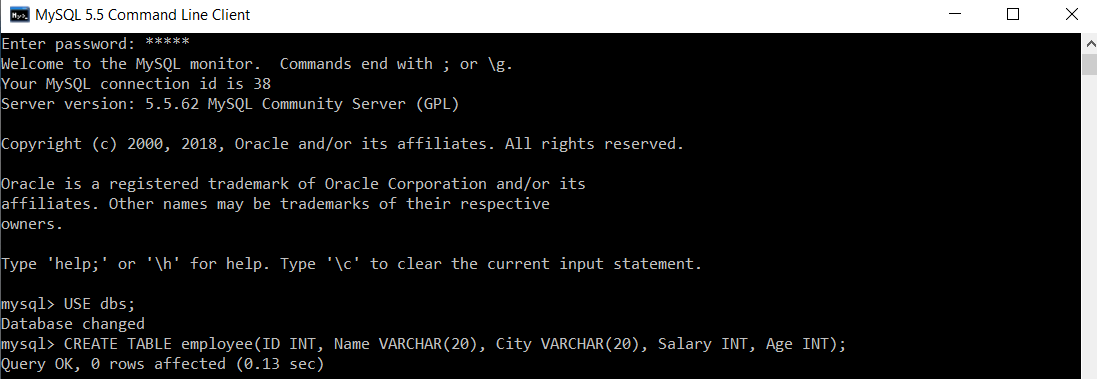SQL Tutorial
SQL Database
SQL Table
SQL Select
SQL Order By
SQL Insert
SQL Update
SQL Delete
Difference
SQL Injection
SQL String Functions
Miscl
- SQL Formatter
- SQL group by
- SQL add/drop/update column operation
- SQL CAST Function
- SQL Comments
- SQL CONCAT Function
- CTE (Common Table Expression)SQL
- How to use distinct in SQL?
- Joining Three or More Tables in SQL
- What is Web SQL?
- How to create functions in SQL?
- How to run SQL Script?
- How to Delete Duplicate Rows in SQL?
- Nth Highest salary
- 12 Codd's Rules
- SQL EXCEPT
- Types of SQL JOIN
- Change datatype of column in SQL
- SQL Auto Increment
- SQL Like
- Commit and Rollback in SQL
- SQL Concatenate
- SQL get month from the date
- Savepoint in SQL
- SQL ORDER BY DATE
- TIME Datatype in SQL
- SQL BETWEEN
- CRUD Operations in SQL
- SQL INDEX
- Scalar Functions in SQL
- SET Operators in SQL
- Types of SQL Commands
- TCL Commands in SQL
- SQL Subquery
- SQL View
- Constraints in SQL
- Pattern Matching in SQL
- SQL Date Functions
- DDL Commands in SQL
- DML Commands in SQL
- SQL CASE
- SQL Inner Join
- SQL IN Operator
- Check Constraint in SQL
- SQL CLAUSES
- SQL LOGICAL OPERATORS
- Delete Column from Table
- Add Column in the Table
- Delete one row in SQL
- Change the Column Value
- How to Add Foreign Key in SQL
- Add a Primary Key
- Insert One or More rows
- How to Use LIKE in SQL
- Cursor in SQL
- Difference Between DROP and Truncate
- SQL Comparison Operators
- SQL COUNT WHERE
- SQL SELECT MIN
- SQL Stored Procedure
- SQL SELECT AVG
- SQL SELECT MAX
- SQL ADD COLUMN
- How to use Auto-Increment in SQL
- SQL Languages
- SQL Arithmetic Operators
- How to Use GROUP BY in SQL
- How to Use ORDER BY in SQL
- Trigger in SQL
- What is Race Condition
- SQL COUNT DISTINCT
PL/SQL Tutorial
Sql Interview Question
SQl Quiz
Commit and Rollback in SQL
- Commit and rollback are the transaction control commands in SQL.
- All the commands that are executed consecutively, treated as a single unit of work and termed as a transaction.
- If you want to save all the commands which are executed in a transaction, then just after completing the transaction, you have to execute the commit command. This command will save all the commands which are executed on a table. All these changes made to the table will be saved to the disk permanently.
- Whenever the commit command is executed in SQL, all the updations which we have carried on the table will be uploaded to the server, and hence our work will be saved.
- The rollback command is used to get back to the previous permanent status of the table, which is saved by the commit command.
- Suppose, we have started editing a table and later thought that the changes that we have recently carried out on a table are not required. Then, in that case, we can roll back our transaction, which simply means to get back to the previous permanent status of the table, which is saved by the commit command.
Let us see few practical examples to understand this concept more clearly. We will use the MySQL database for writing all the queries.
Example 1:
Let us select the existing database dbs.
Then we will write the following query to create a table in the 'dbs' database:

Then, we will start our transaction by using the BEGIN / START TRANSACTION command.

Now, we will insert records in the student table.

We will execute the SELECT query to verify that all the records are inserted successfully in the student table.
You will get the following table as output:
| ID | Name | Percentage | Location | DateOfBirth |
|---|---|---|---|---|
| 1 | Manthan Koli | 79 | Delhi | 2003-08-20 |
| 2 | Dev Dixit | 75 | Pune | 1999-06-17 |
| 3 | Aakash Deshmukh | 87 | Mumbai | 1997-09-12 |
| 4 | Aaryan Jaiswal | 90 | Chennai | 2005-10-02 |
| 5 | Rahul Khanna | 92 | Ambala | 1996-03-04 |
We will commit our transaction to save all the changes permanently to the disk.

Now, turn off the auto-commit by setting the value of auto-commit as 0.

Then we will delete the student record whose ID is 5.

To verify the results of the delete query, we will again use the SELECT query.
| ID | Name | Percentage | Location | DateOfBirth |
|---|---|---|---|---|
| 1 | Manthan Koli | 79 | Delhi | 2003-08-20 |
| 2 | Dev Dixit | 75 | Pune | 1999-06-17 |
| 3 | Aakash Deshmukh | 87 | Mumbai | 1997-09-12 |
| 4 | Aaryan Jaiswal | 90 | Chennai | 2005-10-02 |
Later, we thought that we needed the record which we have deleted in the earlier step, i.e., the record whose ID is 5. As we know, before deleting the record with ID 5, we have stored the entire student table, which contains five records, into the disk with the commit command.
We will execute the ROLLBACK command to get the original table that we have saved before executing the delete command.

After the rollback command, we need to execute the SELECT command to view the records of the student table.
| ID | Name | Percentage | Location | DateOfBirth |
|---|---|---|---|---|
| 1 | Manthan Koli | 79 | Delhi | 2003-08-20 |
| 2 | Dev Dixit | 75 | Pune | 1999-06-17 |
| 3 | Aakash Deshmukh | 87 | Mumbai | 1997-09-12 |
| 4 | Aaryan Jaiswal | 90 | Chennai | 2005-10-02 |
| 5 | Rahul Khanna | 92 | Ambala | 1996-03-04 |
The above results show that the student table containing five records is successfully retrieved from the disk after using the rollback command.
Now, write a query to update the record and set the percentage as 80 for the student whose ID is 1.

To verify the results of the update query, we will again use the SELECT query. Here, this update query will be applied to the table which was retrieved after the rollback command.
| ID | Name | Percentage | Location | DateOfBirth |
|---|---|---|---|---|
| 1 | Manthan Koli | 80 | Delhi | 2003-08-20 |
| 2 | Dev Dixit | 75 | Pune | 1999-06-17 |
| 3 | Aakash Deshmukh | 87 | Mumbai | 1997-09-12 |
| 4 | Aaryan Jaiswal | 90 | Chennai | 2005-10-02 |
| 5 | Rahul Khanna | 92 | Ambala | 1996-03-04 |
Now, we will again rollback our transaction and execute the select query:

| ID | Name | Percentage | Location | DateOfBirth |
|---|---|---|---|---|
| 1 | Manthan Koli | 79 | Delhi | 2003-08-20 |
| 2 | Dev Dixit | 75 | Pune | 1999-06-17 |
| 3 | Aakash Deshmukh | 87 | Mumbai | 1997-09-12 |
| 4 | Aaryan Jaiswal | 90 | Chennai | 2005-10-02 |
| 5 | Rahul Khanna | 92 | Ambala | 1996-03-04 |
We can see that all the records are retrieved as they were earlier before applying the update query.
Example 2:
Let us select the existing database dbs.
Now we will write the following query to create a table in the 'dbs' database:

Then, we will start our transaction by using the BEGIN / START TRANSACTION command.

Now, we will insert records in the employee table.

We will execute the SELECT query to verify that all the records are inserted successfully in the employee table.
We will get the following table as output:
| ID | Name | City | Salary | Age |
|---|---|---|---|---|
| 1 | Priyanka Bagul | Nasik | 26000 | 20 |
| 2 | Riya Sharma | Mumbai | 72000 | 28 |
| 3 | Neha Verma | Varanasi | 37000 | 19 |
| 4 | Neeta Desai | Nasik | 39500 | 21 |
| 5 | Priya Wagh | Udaipur | 60000 | 32 |
We will commit our transaction to save all the changes permanently to the disk.

Now, turn off the auto-commit by setting the value of auto-commit as 0.

Then we will add a new record to the employee table.

To verify the results of the insert query, we will again use the SELECT query.
| ID | Name | City | Salary | Age |
|---|---|---|---|---|
| 1 | Priyanka Bagul | Nasik | 26000 | 20 |
| 2 | Riya Sharma | Mumbai | 72000 | 28 |
| 3 | Neha Verma | Varanasi | 37000 | 19 |
| 4 | Neeta Desai | Nasik | 39500 | 21 |
| 5 | Priya Wagh | Udaipur | 60000 | 32 |
| 6 | Sneha Tiwari | Kanpur | 38000 | 38 |
Later, we thought that we don't need the record which we have inserted in the earlier step, i.e., the record whose ID is 6. As we know, before inserting the record with ID 6, we have stored the entire employee table, which contains five records, into the disk with the commit command.
We will execute the ROLLBACK command to get the original table that we have saved before executing the insert command.

After the rollback command, we need to execute the SELECT command to view the records of the employee table.
| ID | Name | City | Salary | Age |
|---|---|---|---|---|
| 1 | Priyanka Bagul | Nasik | 26000 | 20 |
| 2 | Riya Sharma | Mumbai | 72000 | 28 |
| 3 | Neha Verma | Varanasi | 37000 | 19 |
| 4 | Neeta Desai | Nasik | 39500 | 21 |
| 5 | Priya Wagh | Udaipur | 60000 | 32 |
We can see that all the records are retrieved as they were earlier before applying the insert query.


